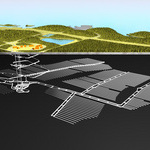 Many people falsely believe that nuclear waste is an unsolved problem – the truth is that nuclear waste has been stored safely ever since nuclear energy came into being more than 50 years ago, while long term storage facilities are currently being built. Countries which have advanced waste programs include Sweden, UK, Finland and the US.
Many people falsely believe that nuclear waste is an unsolved problem – the truth is that nuclear waste has been stored safely ever since nuclear energy came into being more than 50 years ago, while long term storage facilities are currently being built. Countries which have advanced waste programs include Sweden, UK, Finland and the US.
The storage of spent nuclear fuel is a political problem only – not a technical one. Safe methods for the final disposal of high-level wastes are technically proven; the international consensus is that this should be deep geological disposal.
There is a fascinating story about an entirely natural nuclear reactor that existed 2 billion years ago in Gabon, and the waste has not moved more than a few metres since.
Nuclear power is the only energy-producing technology which takes full responsibility for all its wastes and fully costs this into the product. The amount of radioactive waste is very small relative to wastes produced by fossil fuel electricity generation. Used nuclear fuel may be treated as a resource or simply as a waste.
Radioactive waste arises from numerous industrial and medical processes, of which nuclear energy production is the most important because of the volumes generated and its long lived nature. Radioactive waste is considered in three categories depending on its level of radioactivity and the length of time it remains hazardous: Low Level Waste (LLW), Intermediate Level Waste (ILW) and High Level Waste (HLW). It is important to note that the radioactivity of used fuel and all nuclear wastes diminishes with time, unlike other hazardous substances.
Waste disposal: The nuclear industry adopts the policy of concentration and containment in processing waste. This is the opposite of the policy used in many industries (including power generation) which is to dilute and disperse.
Disposal of LLW and ILW is a mature practice. Low-level waste (including that from Irish industry and hospitals) is allowed to decay naturally to background levels, and then buried in carefully selected shallow land disposal sites. Intermediate level waste is concentrated, contained and stored. Much of it has been disposed of by burying in carefully selected land sites, and some in deep-sea sites.
The disposal of HLW is also possible. High level waste is initially stored in ponds prior to vitrification, to allow some of the heat to dissipate and the radioactivity to decay. Some has later been concentrated, contained and stored safely, awaiting final disposal. No nation has yet completed a long term storage facility for high level waste – although a facility is under construction in Finland (video) – mainly because:
• waste storage is not a pressing issue,
• the quantities are small, and
• most of what is considered waste today could be used as fuel tomorrow.
The complete nuclear fuel life cycle is explained clearly here.
Because spent fuel from today’s reactors could become the fuel for tomorrow’s reactors with appropriate treatment, it may not be wise to bury the waste in such a manner as to make it unusable in future.
Nuclear Recycling: Although not required for nuclear energy, spent nuclear fuel can also be recycled to extract more energy from the fuel. Recycling is explained in more detail in the video below.